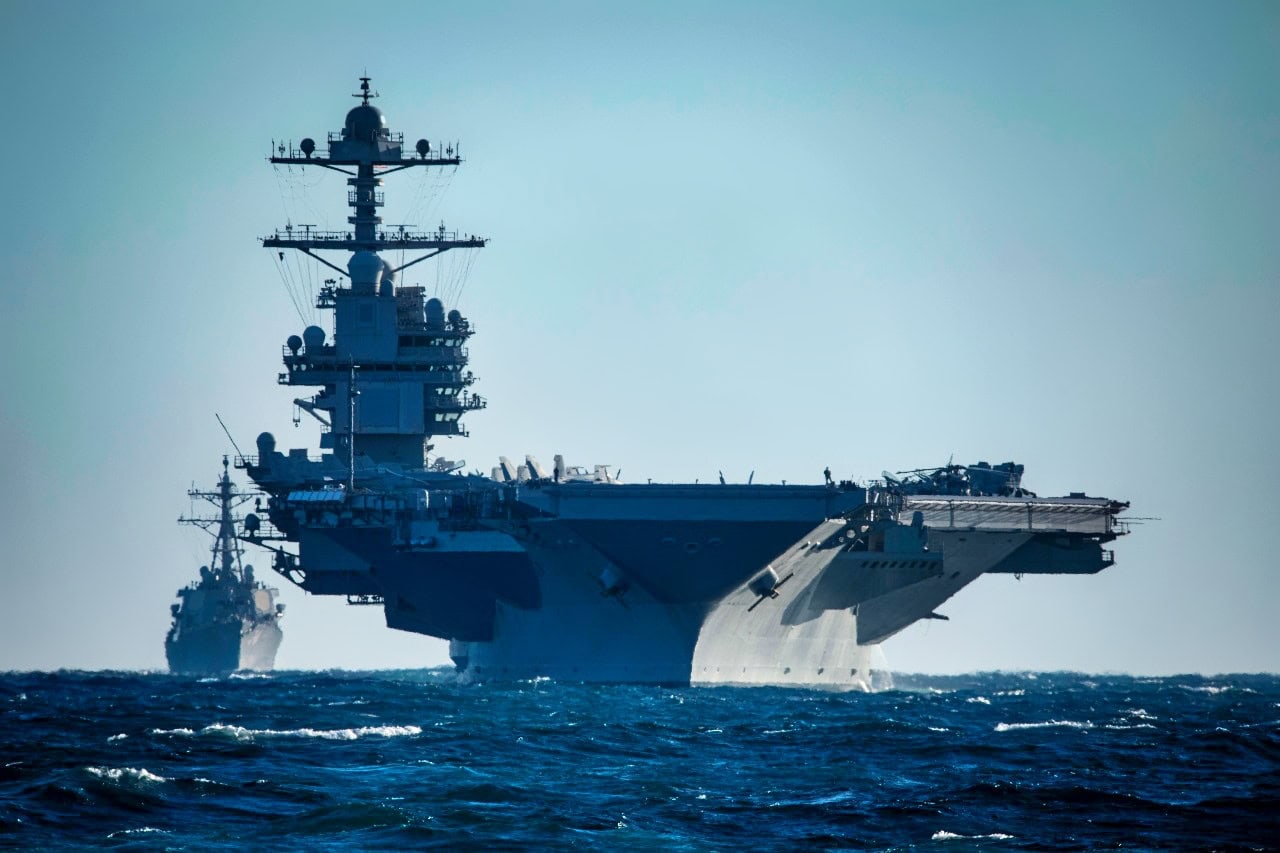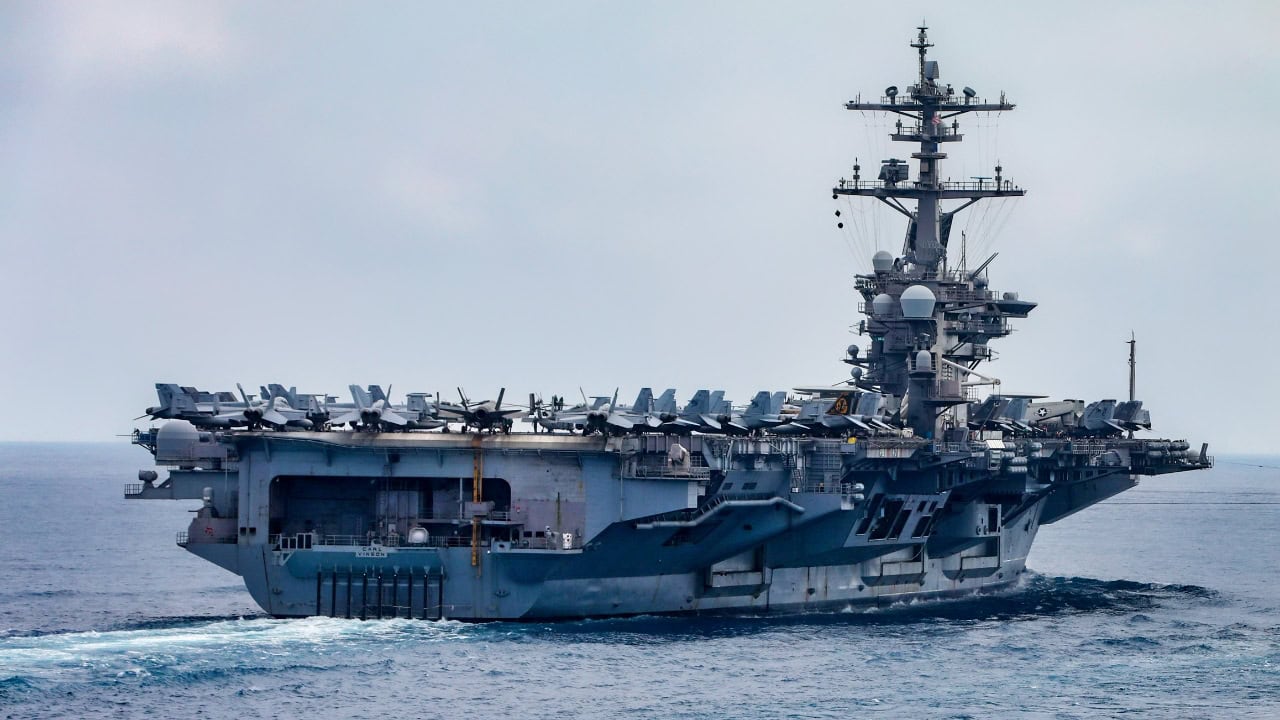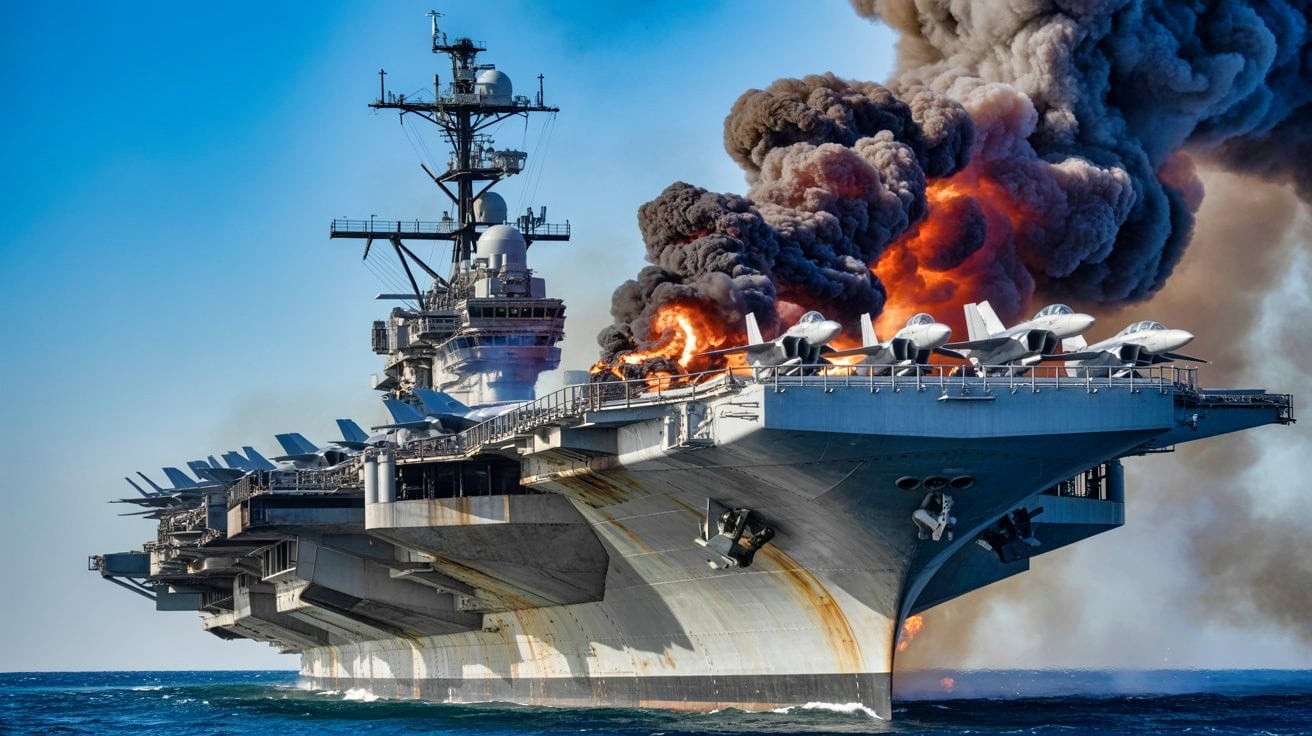In a recent incident in the Red Sea, the US Navy announced that an F/A-18 Super Hornet fighter jet was lost at sea after it fell overboard from the USS Harry S. Truman aircraft carrier while being towed on board.
Reports also indicated that the Harry S. Truman was conducting evasive maneuvers due to a Houthi attack, which may have resulted in the loss of the jet.

A view from the Ticonderoga-class guided missile cruiser USS Normandy (CG 60) of the first-in-class aircraft carrier USS Gerald R. Ford (CVN 78) and the Arleigh Burke-class guided missile destroyers USS Thomas Hudner (DDG 116), USS Ramage (DDG 61) and USS McFaul (DDG 74) as the ships steam in formation during a drill while underway as part of the Gerald R. Ford Carrier Strike Group March 5, 2023. Ford Carrier Strike Group is underway in the Atlantic Ocean executing its Composite Training Unit Exercise (COMPTUEX), an intense, multi-week exercise designed to fully integrate a carrier strike group as a cohesive, multi-mission fighting force and to test their ability to carry out sustained combat operations from the sea. As the first-in-class ship of Ford-class aircraft carriers, CVN 78 represents a generational leap in the U.S. Navy’s capacity to project power on a global scale. (U.S. Navy photo by Mass Communication Specialist 2nd Class Malachi Lakey)
This incident raises the question of what the Houthis are capable of, as well as how prepared the Navy is to take on threats in a protracted campaign.
Background: What Happened?
On April 28th, the US Navy announced the loss of the aircraft during an incident. The plane was reportedly being towed via tow tractor when the USS Harry S. Truman suddenly shifted its course, resulting in the tow tractor losing control and both it and the F/A-18 falling into the ocean.
According to initial reports, no sailors were harmed aside from one who received only minor injuries. “The F/A-18E was actively under tow in the hangar bay when the move crew lost control of the aircraft. The aircraft and tow tractor were lost overboard,” the Navy said in a statement. The jet was part of Strike Fighter Squadron 136.
A US official also reported that the Harry S. Truman was conducting maneuvers to avoid fire from a Houthi attack. Yemen’s Houthi rebels, for their part, claimed on Monday to have launched a drone and missile attack on the aircraft carrier, which is in the Red Sea as part of the US military’s major operation against the Iran-backed group. Currently, there is no information on the nature of the attack or what sort of maneuvers the Truman was taking. Whatever the case, a $60 million aircraft was lost as a result.
Can the Houthis Hit an Aircraft Carrier?
This incident raises an important question: how strong are the Houthis’ anti-ship capabilities? After months of launching strikes against Houthi leadership, the rebels continue to harass shipping vessels and American warships in the Red Sea. The Houthis have been developing a range of anti-ship capabilities over the past decade, significantly enhancing their ability to threaten maritime traffic in the Red Sea and surrounding areas.

SOUTH CHINA SEA (Feb. 2, 2025) The Nimitz-class aircraft carrier USS Carl Vinson (CVN 70) conducts a replenishment-at-sea with the dry cargo and ammunition ship USNS Carl Brashear (T-AKE 7) Feb. 2, 2025. The Carl Vinson Carrier Strike Group is underway conducting routine operations in the U.S. 7th Fleet area of operations. (U.S. Navy photo by Mass Communication Specialist 1st Class Jacob I. Allison)
The Houthis began acquiring anti-ship missiles around 2014-2015, initially from Yemeni military stocks. These early acquisitions included Soviet-made P-21 and P-22 missiles (RS-SSC-3 Styx) and Chinese C-801 missiles (YJ-81/CH-SS-N-4 Sardine), designated Rubezh B21/B22 and Al-Mandab. While these missiles were relatively outdated, they marked the beginning of the Houthis’ ability to threaten maritime traffic.
Since then, the Houthis have significantly upgraded their arsenal, largely due to Iranian assistance. Iran has provided more advanced missile systems, including the Noor (C-802) and Khalij Fars (Persian Gulf) missiles. These missiles have longer ranges and better targeting capabilities, allowing the Houthis to strike targets with greater precision.
The Houthis have also developed their own intelligence apparatus with aid from their Iranian Doners. The Houthis have employed various methods to enhance their targeting accuracy, including coastal radars and external surveillance assets.
In 2016, they used coastal radars to target the Emirati troop-transport catamaran HSV-2 Swift and attempted to strike the USS Mason, an Arleigh Burke-class guided missile destroyer. These attacks demonstrated their ability to threaten military vessels, although the USS Mason successfully defended against the missile strikes.
Aircraft Carriers are Hard to Sink
On paper, it is possible for the Houthis to hit an aircraft carrier, but in reality, this is much harder to achieve. Carrier strike groups form a layered defense system around the carrier, offering sophisticated missile defense systems to counter any incoming threats.
Even if a missile or a drone were to bypass the missile defense, carriers and their escorts are equipped with short-range systems like the Aegis Combat System, which are designed to shoot down closer-range threats.

Aircraft Carrier U.S. Navy. Image Credit: U.S. Navy
Hitting an aircraft carrier is a difficult task but not impossible. If the Houthis continued a barrage for long enough, they could exhaust a carrier’s air defenses and make it a sitting target. This, however, poses a different problem. Carriers are difficult to sink.
Nimitz-class aircraft carriers, though aging, are some of the largest military vessels ever built and would take many, many direct hits to sink, even from anti-ship missiles. However, a few well-placed shots could render the deck unusable and take the carrier out of action completely.
The most recent event in the Red Sea is at best a minor humiliation for the Navy, and at worst an indicator of how unprepared the US is for protracted naval warfare. The US Navy has been operating in the Red Sea for more than a year now and has been struggling against a group of rebels reliant entirely on Iran.
Imagine how much more the Navy in its current state would struggle against a near-peer like China or even Russia with vastly superior targeting and industrial capabilities.
About the Author:
Isaac Seitz, a 19FortyFive Defense Columnist, graduated from Patrick Henry College’s Strategic Intelligence and National Security program. He has also studied Russian at Middlebury Language Schools and has worked as an intelligence Analyst in the private sector.

